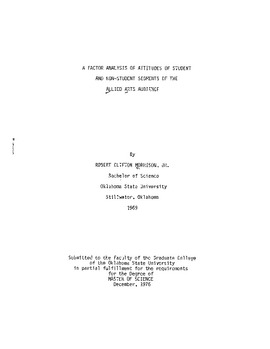| dc.contributor.advisor | Ward, W. J. | |
| dc.contributor.author | Morrison, Robert Clifton, Jr. | |
| dc.date.accessioned | 2015-10-14T21:37:36Z | |
| dc.date.available | 2015-10-14T21:37:36Z | |
| dc.date.issued | 1976-12-01 | |
| dc.identifier.uri | https://hdl.handle.net/11244/19620 | |
| dc.description.abstract | In 1969 the Allied Arts and Other Campus Entertainment Committee was brought into existence: To set policy on the administration of the Allied Arts and campus entertainment programs,� serve in an advisory capacity to the Concert Manager in the execution of his responsibilities . . . serve as a coordinating and scheduling body for campus entertainment . . . (and) work toward the elimination of competitive scheduling in the area of popular entertainment. (Allied Arts Policy Statement, September, 1969). The Concert Manager (this title was later changed to Student Program Coordinator) referred to above is charged with the general administration of the programs of Allied Arts, acting as a promoter/producer for specific events, and carrying out public relations for Allied Arts. (Oklahoma State University Concert Manager Job Description, apoted January, 1970). The author has been the Oklahoma StateUniversity Concert Manager since August 1972. During this tenure he has been confrontated with numerous problems in programming the performing arts at Oklahoma State University (OSU). Two of these problems are examined in this study. Allied Arts programs basically two types of live entertainment: the performing fine arts and popular or "Big-Name" concerts. In the performing fine arts area Allied Arts has two audience segments: students of the University and non-student members of the University staff, Stillwater residents and so on. The problem here was: is it necessary to deal with these two groups as different audience segments with distinct likes and dislikes or were they generally homogeneous as audience members. The answer to this question would have a massive impact on how the Allied Arts fine arts series is booked. Both audience segments contribute significantly to the income of the program. Therefore, as many of their programming needs as possible must be met. This problem was the focus of an exploratory study by the author in the Spring of 1974. The second problem concerns popular or "Big-Name" concerts. Since about 1971 there has been a drastic decline in the financial success of popular concerts on the OSU campus. In November of 1973 the author wrote an unpublished position paper to explain this decline. (Morrison, R. C., Position Paper on "Big-Name" Programming at Oklahoma State University, November, 1973). This thesis in part is an attempt to verify attitudes conjectured to be prevalent among OSU students in the 1973 paper. Statistical verification of these attitudes will go a long way toward documenting the situation in "Big-Name" programming to actually be as hypothesized in the Position Paper. This study isolates prevalent attitudes among students in these terms and thus adds hard data to the theoretical framework generated in the initial paper. | |
| dc.format | application/pdf | |
| dc.language | en_US | |
| dc.publisher | Oklahoma State University | |
| dc.rights | Copyright is held by the author who has granted the Oklahoma State University Library the non-exclusive right to share this material in its institutional repository. Contact Digital Library Services at lib-dls@okstate.edu or 405-744-9161 for the permission policy on the use, reproduction or distribution of this material. | |
| dc.title | Factor Analysis of Attitudes of Student and Non-Student Segments of the Allied Arts Audience | |
| dc.type | text | |
| dc.contributor.committeeMember | Groom, Lemuel D. | |
| dc.contributor.committeeMember | Steng, William R. | |
| osu.filename | Thesis-1976-M881f.pdf | |
| osu.accesstype | Open Access | |
| dc.description.department | Mass Communication | |
| dc.type.genre | Thesis | |
